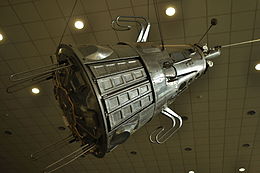
Back Spoetnik 3 Afrikaans Sputnik 3 AN سبوتنك 3 Arabic Sputnik 3 AST Спутник-3 Bulgarian স্পুটনিক ৩ Bengali/Bangla Spútnik 3 Catalan Sputnik 3 Czech Sputnik#Sputnik 3 German Σπούτνικ 3 Greek
 A model of Sputnik 3 in the Tsiolkovsky State Museum of the History of Cosmonautics | |
| Mission type | Earth Science |
|---|---|
| Operator | OKB-1 |
| Harvard designation | 1958 Delta 2 |
| COSPAR ID | 1958-004B |
| SATCAT no. | 00008 |
| Website | NASA NSSDC Master Catalog |
| Mission duration | 692 days |
| Spacecraft properties | |
| Manufacturer | Korolev Design Bureau |
| Launch mass | 1,327 kilograms (2,926 lb) |
| Start of mission | |
| Launch date | 15 May 1958, 07:12:00 UTC |
| Rocket | Sputnik 8A91 |
| Launch site | Baikonur 1/5 |
| End of mission | |
| Decay date | April 6, 1960 |
| Orbital parameters | |
| Reference system | Geocentric |
| Regime | Low Earth |
| Semi-major axis | 7,418.7 kilometres (4,609.8 mi) |
| Eccentricity | 0.110932 |
| Perigee altitude | 217 kilometres (135 mi) |
| Apogee altitude | 1,864 kilometres (1,158 mi) |
| Inclination | 65.18° |
| Period | 105.9 minutes |
| Epoch | 15 May 1958 07:12:00 UTC |
| Instruments | |
|---|---|
| Quadrupole Mass Spectrometer | Composition of the upper atmosphere |
| Ionization and Magnetic Manometer | Pressure of the upper atmosphere |
| Geiger counters | Charged particles |
| Piezo-Electric Meteorite Counter | Micrometeoroids |
| Fluxgate Magnetometer | Magnetic field |
| Field Mill Electrometer | Electric field |
Sputnik 3 (Russian: Спутник-3, Satellite 3) was a Soviet satellite launched on 15 May 1958 from Baikonur Cosmodrome by a modified R-7/SS-6 ICBM. The scientific satellite carried a large array of instruments for geophysical research of the upper atmosphere and near space.

Sputnik 3 was the only Soviet satellite launched in 1958. Like its American counterpart, Vanguard 1, Sputnik 3 reached orbit during the International Geophysical Year.[1]
- ^ Green, Constance McLaughlin, and Lomax, Milton.. Vanguard a History, Washington D.C., National Aeronautics and Space Administration, 1970, p. 219. NASA SP-4202